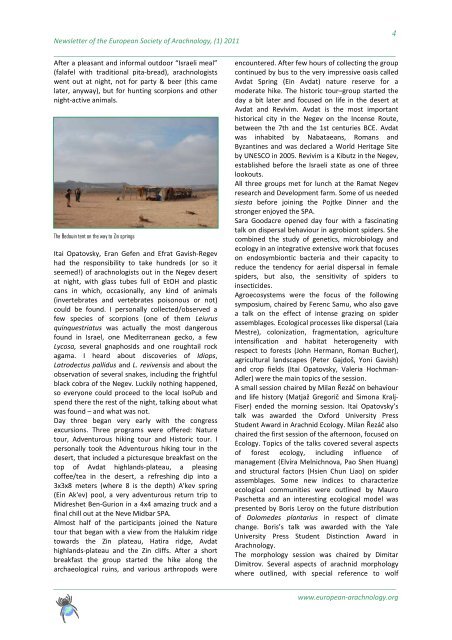Newsletter 1 - European Society of Arachnology
Newsletter 1 - European Society of Arachnology
Newsletter 1 - European Society of Arachnology
Create successful ePaper yourself
Turn your PDF publications into a flip-book with our unique Google optimized e-Paper software.
<strong>Newsletter</strong> <strong>of</strong> the <strong>European</strong> <strong>Society</strong> <strong>of</strong> <strong>Arachnology</strong>, (1) 2011<br />
___________________________________________________________________________<br />
After a pleasant and informal outdoor “Israeli meal”<br />
(falafel with traditional pita-bread), arachnologists<br />
went out at night, not for party & beer (this came<br />
later, anyway), but for hunting scorpions and other<br />
night-active animals.<br />
The Bedouin tent on the way to Zin springs<br />
Itai Opatovsky, Eran Gefen and Efrat Gavish-Regev<br />
had the responsibility to take hundreds (or so it<br />
seemed!) <strong>of</strong> arachnologists out in the Negev desert<br />
at night, with glass tubes full <strong>of</strong> EtOH and plastic<br />
cans in which, occasionally, any kind <strong>of</strong> animals<br />
(invertebrates and vertebrates poisonous or not)<br />
could be found. I personally collected/observed a<br />
few species <strong>of</strong> scorpions (one <strong>of</strong> them Leiurus<br />
quinquestriatus was actually the most dangerous<br />
found in Israel, one Mediterranean gecko, a few<br />
Lycosa, several gnaphosids and one roughtail rock<br />
agama. I heard about discoveries <strong>of</strong> Idiops,<br />
Latrodectus pallidus and L. revivensis and about the<br />
observation <strong>of</strong> several snakes, including the frightful<br />
black cobra <strong>of</strong> the Negev. Luckily nothing happened,<br />
so everyone could proceed to the local IsoPub and<br />
spend there the rest <strong>of</strong> the night, talking about what<br />
was found – and what was not.<br />
Day three began very early with the congress<br />
excursions. Three programs were <strong>of</strong>fered: Nature<br />
tour, Adventurous hiking tour and Historic tour. I<br />
personally took the Adventurous hiking tour in the<br />
desert, that included a picturesque breakfast on the<br />
top <strong>of</strong> Avdat highlands-plateau, a pleasing<br />
c<strong>of</strong>fee/tea in the desert, a refreshing dip into a<br />
3x3x8 meters (where 8 is the depth) A'kev spring<br />
(Ein Ak'ev) pool, a very adventurous return trip to<br />
Midreshet Ben-Gurion in a 4x4 amazing truck and a<br />
final chill out at the Neve Midbar SPA.<br />
Almost half <strong>of</strong> the participants joined the Nature<br />
tour that began with a view from the Halukim ridge<br />
towards the Zin plateau, Hatira ridge, Avdat<br />
highlands-plateau and the Zin cliffs. After a short<br />
breakfast the group started the hike along the<br />
archaeological ruins, and various arthropods were<br />
encountered. After few hours <strong>of</strong> collecting the group<br />
continued by bus to the very impressive oasis called<br />
Avdat Spring (Ein Avdat) nature reserve for a<br />
moderate hike. The historic tour–group started the<br />
day a bit later and focused on life in the desert at<br />
Avdat and Revivim. Avdat is the most important<br />
historical city in the Negev on the Incense Route,<br />
between the 7th and the 1st centuries BCE. Avdat<br />
was inhabited by Nabataeans, Romans and<br />
Byzantines and was declared a World Heritage Site<br />
by UNESCO in 2005. Revivim is a Kibutz in the Negev,<br />
established before the Israeli state as one <strong>of</strong> three<br />
lookouts.<br />
All three groups met for lunch at the Ramat Negev<br />
research and Development farm. Some <strong>of</strong> us needed<br />
siesta before joining the Pojtke Dinner and the<br />
stronger enjoyed the SPA.<br />
Sara Goodacre opened day four with a fascinating<br />
talk on dispersal behaviour in agrobiont spiders. She<br />
combined the study <strong>of</strong> genetics, microbiology and<br />
ecology in an integrative extensive work that focuses<br />
on endosymbiontic bacteria and their capacity to<br />
reduce the tendency for aerial dispersal in female<br />
spiders, but also, the sensitivity <strong>of</strong> spiders to<br />
insecticides.<br />
Agroecosystems were the focus <strong>of</strong> the following<br />
symposium, chaired by Ferenc Samu, who also gave<br />
a talk on the effect <strong>of</strong> intense grazing on spider<br />
assemblages. Ecological processes like dispersal (Laia<br />
Mestre), colonization, fragmentation, agriculture<br />
intensification and habitat heterogeneity with<br />
respect to forests (John Hermann, Roman Bucher),<br />
agricultural landscapes (Peter Gajdoš, Yoni Gavish)<br />
and crop fields (Itai Opatovsky, Valeria Hochman-<br />
Adler) were the main topics <strong>of</strong> the session.<br />
A small session chaired by Milan Řezáč on behaviour<br />
and life history (Matjaž Gregorič and Simona Kralj-<br />
Fiser) ended the morning session. Itai Opatovsky’s<br />
talk was awarded the Oxford University Press<br />
Student Award in Arachnid Ecology. Milan Řezáč also<br />
chaired the first session <strong>of</strong> the afternoon, focused on<br />
Ecology. Topics <strong>of</strong> the talks covered several aspects<br />
<strong>of</strong> forest ecology, including influence <strong>of</strong><br />
management (Elvira Melnichnova, Pao Shen Huang)<br />
and structural factors (Hsien Chun Liao) on spider<br />
assemblages. Some new indices to characterize<br />
ecological communities were outlined by Mauro<br />
Paschetta and an interesting ecological model was<br />
presented by Boris Leroy on the future distribution<br />
<strong>of</strong> Dolomedes plantarius in respect <strong>of</strong> climate<br />
change. Boris’s talk was awarded with the Yale<br />
University Press Student Distinction Award in<br />
<strong>Arachnology</strong>.<br />
The morphology session was chaired by Dimitar<br />
Dimitrov. Several aspects <strong>of</strong> arachnid morphology<br />
where outlined, with special reference to wolf<br />
_______________________________________________________________________<br />
www.european-arachnology.org<br />
4
















